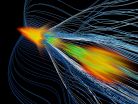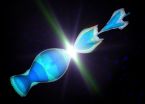(Press-News.org) A study led by researchers from the U.S. Department of Energy's (DOE) SLAC National Accelerator Laboratory and the University of California, Los Angeles has demonstrated a new, efficient way to accelerate positrons, the antimatter opposites of electrons. The method may help boost the energy and shrink the size of future linear particle colliders - powerful accelerators that could be used to unravel the properties of nature's fundamental building blocks.
The scientists had previously shown that boosting the energy of charged particles by having them "surf" a wave of ionized gas, or plasma, works well for electrons. While this method by itself could lead to smaller accelerators, electrons are only half the equation for future colliders. Now the researchers have hit another milestone by applying the technique to positrons at SLAC's Facility for Advanced Accelerator Experimental Tests (FACET), a DOE Office of Science User Facility.
"Together with our previous achievement, the new study is a very important step toward making smaller, less expensive next-generation electron-positron colliders," said SLAC's Mark Hogan, co-author of the study published today in Nature. "FACET is the only place in the world where we can accelerate positrons and electrons with this method."
SLAC Director Chi-Chang Kao said, "Our researchers have played an instrumental role in advancing the field of plasma-based accelerators since the 1990s. The recent results are a major accomplishment for the lab, which continues to take accelerator science and technology to the next level."
Shrinking Particle Colliders
Researchers study matter's fundamental components and the forces between them by smashing highly energetic particle beams into one another. Collisions between electrons and positrons are especially appealing, because unlike the protons being collided at CERN's Large Hadron Collider - where the Higgs boson was discovered in 2012 - these particles aren't made of smaller constituent parts.
"These collisions are simpler and easier to study," said SLAC's Michael Peskin, a theoretical physicist not involved in the study. "Also, new, exotic particles would be produced at roughly the same rate as known particles; at the LHC they are a billion times more rare."
However, current technology to build electron-positron colliders for next-generation experiments would require accelerators that are tens of kilometers long. Plasma wakefield acceleration is one way researchers hope to build shorter, more economical accelerators.
Previous work showed that the method works efficiently for electrons: When one of FACET's tightly focused bundles of electrons enters an ionized gas, it creates a plasma "wake" that researchers use to accelerate a trailing second electron bunch.
Creating a Plasma Wake for Antimatter
For positrons - the other required particle ingredient for electron-positron colliders - plasma wakefield acceleration is much more challenging. In fact, many scientists believed that no matter where a trailing positron bunch was placed in a wake, it would lose its compact, focused shape or even slow down.
"Our key breakthrough was to find a new regime that lets us accelerate positrons in plasmas efficiently," said study co-author Chandrashekhar Joshi from UCLA.
Instead of using two separate particle bunches - one to create a wake and the other to surf it - the team discovered that a single positron bunch can interact with the plasma in such a way that the front of it generates a wake that both accelerates and focuses its trailing end. This occurs after the positrons have traveled about four inches through the plasma.
"In this stable state, about 1 billion positrons gained 5 billion electronvolts of energy over a short distance of only 1.3 meters," said former SLAC researcher Sébastien Corde, the study's first author, who is now at the Ecole Polytechnique in France. "They also did so very efficiently and uniformly, resulting in an accelerated bunch with a well-defined energy."
Looking into the Future
All of these properties are important qualities for particle beams in accelerators. In the next step, the team will look to further improve their experiment.
"We performed simulations to understand how the stable state was created," said co-author Warren Mori of UCLA. "Based on this understanding, we can now use simulations to look for ways of exciting suitable wakes in an improved, more controlled way. This will lead to ideas for future experiments."
Although plasma-based particle colliders will not be built in the near future, the method could be used to upgrade existing accelerators much sooner.
"It's conceivable to boost the performance of linear accelerators by adding a very short plasma accelerator at the end," Corde said. "This would multiply the accelerator's energy without making the entire structure significantly longer."
INFORMATION:
Additional contributors included researchers from the University of Oslo in Norway and Tsinghua University in China. The research was supported by DOE, the National Science Foundation, the Research Council of Norway and the Thousand Young Talents Program of China.
SLAC is a multi-program laboratory exploring frontier questions in photon science, astrophysics, particle physics and accelerator research. Located in Menlo Park, California, SLAC is operated by Stanford University for the U.S. Department of Energy Office of Science. To learn more, please visit http://www.slac.stanford.edu.
SLAC National Accelerator Laboratory is supported by the Office of Science of the U.S. Department of Energy. The Office of Science is the single largest supporter of basic research in the physical sciences in the United States, and is working to address some of the most pressing challenges of our time. For more information, please visit science.energy.gov.
They're among the most powerful tools for shedding new light on cancer growth and evolution, but mathematical models of the disease for years have faced an either/or stand off.
Though models have been developed that capture the spatial aspects of tumors, those models typically don't study genetic changes. Non-spatial models, meanwhile, more accurately portray tumors' evolution, but not their three-dimensional structure.
A collaboration between Harvard, Edinburgh, and Johns Hopkins Universities including Martin Nowak, Director of the Program for Evolutionary Dynamics ...
New insight into methanotrophs, bacteria that can oxidise methane, may help us develop an array of biotechnological applications that exploit methane and protect our environment from this potent greenhouse gas.
Publishing in Nature, scientists led by Newcastle University have provided new understanding of how methanotrophs are able to use large quantities of copper for methane oxidation.
They have identified a new family of copper storage proteins called Csp that are present in a range of bacteria. These proteins store metal in a way that has not been seen previously ...
It's not a huge mystery why Los Angeles experiences earthquakes. The city sits near a boundary between two tectonic plates -- they shift, we shake. But what about places that aren't along tectonic plate boundaries?
For example, seismicity on the North American plate occurs as far afield as southern Missouri, where earthquakes between 1811 and 1812 estimated at around magnitude 7 caused the Mississippi River to flow backward for hours.
Until now, the cause of that seismicity has remained unclear.
While earthquakes along tectonic plate boundaries are caused by motion ...
The Pacific Northwest is abundantly dotted with wildfires in Washington, Oregon, Idaho and Montana. There are over 27 fires listed in the Inciweb database for the state of Washington. The largest active fire listed is the Okanogan Complex Fire which is currently at 256,567 acres and has 1,250 personnel working the fire. This fire began as a lightning strike on August 15, 2015. It is only 10% contained at present. Governor Inslee's request for a federal Emergency Declaration to provide additional resources to cover some of the costs related to multiple wildfires burning ...
Mostly untouched for 100 years, 15 Roman-era Egyptian mummy portraits and panel paintings were literally dusted off by scientists and art conservators from Northwestern University and the Phoebe A. Hearst Museum of Anthropology as they set out to investigate the materials the painters used nearly 2,000 years ago.
What the researchers discovered surprised them, because it was hidden from the naked eye: the ancient artists used the pigment Egyptian blue as material for underdrawings and for modulating color -- a finding never before documented. Because blue has to be manufactured, ...
UC San Francisco researchers have for the first time developed a method to precisely control embryonic stem cell differentiation with beams of light, enabling them to be transformed into neurons in response to a precise external cue.
The technique also revealed an internal timer within stem cells that lets them tune out extraneous biological noise but transform rapidly into mature cells when they detect a consistent, appropriate molecular signal, the authors report in a study published online August 26 in Cell Systems.
"We've discovered a basic mechanism the cell uses ...
Companies can promote creativity in employees by encouraging them to network beyond their immediate business networks, according to a new study by management experts at Rice University, Australian National University (ANU), Erasmus University Rotterdam, Monash University in Clayton, Australia, and the University of Los Andes in Bogota, Colombia.
"Social networks can be important sources of information and insight that may spark employee creativity," the authors said. "The cross-fertilization of ideas depends not just on access to information and insights through one's ...
CAMBRIDGE, Mass.--For more than a decade, gene sequencers have been improving more rapidly than the computers required to make sense of their outputs. Searching for DNA sequences in existing genomic databases can already take hours, and the problem is likely to get worse.
Recently, Bonnie Berger's group at MIT's Computer Science and Artificial Intelligence Laboratory (CSAIL) has been investigating techniques to make biological and chemical data easier to analyze by, in some sense, compressing it.
In the latest issue of the journal Cell Systems, Berger and colleagues ...
Among our greatest achievements as humans, some might say, is our cumulative technological culture -- the tool-using acumen that is passed from one generation to the next. As the implements we use on a daily basis are modified and refined over time, they seem to evolve right along with us.
A similar observation might be made regarding the New Caledonian crow, an extremely smart corvid and the only non-human species hypothesized to possess its own cumulative technological culture. How the birds transmit knowledge to each other is the focus of a study by Corina Logan, a ...
Two studies and an editorial published online by JAMA Psychiatry examine associations between cannabis use and the brain.
Cannabis, also known as marijuana, is a popular recreational drug and its legal status has been a source of enduring controversy.
In the first study, David Pagliaccio, Ph.D., formerly of Washington University in St. Louis, and now at the National Institute of Mental Health, Bethesda, Md., and coauthors analyzed data from a group of twin/siblings (n=483 with 262 participants reporting ever using cannabis in their lifetime) to determine whether cannabis ...




